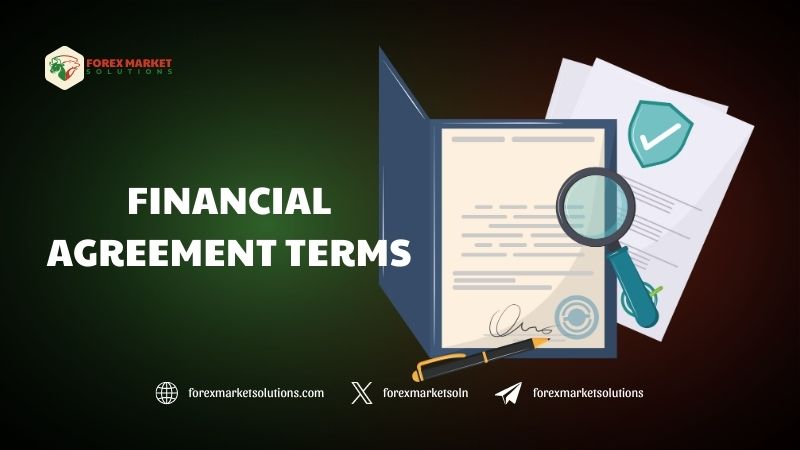Navigating the world of finance often involves signing contracts, whether for loans, investments, or trading accounts. At the heart of these documents lie financial agreement terms, the critical details that define rights, obligations, and risks for all parties involved. In 2025, as financial landscapes evolve with digital currencies, regulatory shifts, and global economic trends, understanding these terms has never been more essential. A clear grasp of what’s written in these agreements can mean the difference between a secure deal and an unexpected pitfall, empowering individuals and businesses to make informed decisions. This comprehensive guide breaks down the essentials of financial agreement terms, offering insights into their structure, significance, and practical application in today’s dynamic environment.

Financial agreements are the backbone of transactions, from personal mortgages to Forex brokerage contracts. They outline expectations, protect against disputes, and ensure clarity in an otherwise complex field. Yet, their dense language and legal nuances can intimidate even seasoned professionals. By demystifying financial agreement terms, this article aims to equip you with the knowledge to confidently review contracts, spot red flags, and negotiate better outcomes. Whether you’re a beginner stepping into financial markets or a veteran refining your approach, these insights will prove invaluable as you navigate agreements in 2025.
The Purpose and Structure of Financial Agreements
To fully appreciate financial agreement terms, it’s worth starting with their purpose. These contracts serve as legally binding frameworks that govern financial relationships, ensuring all parties understand their roles. They exist to minimize ambiguity, allocate risk, and provide recourse if something goes wrong. In essence, they’re a roadmap for how money moves, who controls it, and what happens under various scenarios.
A typical financial agreement follows a structured format, beginning with an introduction that identifies the parties—say, a borrower and a lender or a trader and a broker. This section sets the stage, naming the individuals or entities entering the contract. Following this, the agreement defines its scope, detailing the transaction’s nature, such as a loan amount, investment commitment, or trading account setup. The core of the document lies in its terms and conditions, where specifics like interest rates, repayment schedules, fees, and penalties come into play. These clauses form the meat of financial agreement terms, dictating how the deal unfolds over time.
Beyond the operational details, agreements include provisions for dispute resolution, termination conditions, and legal jurisdiction. For example, a Forex trading contract might specify arbitration in case of disagreements or outline penalties for early withdrawal. This structure ensures every angle is covered, from routine operations to worst-case scenarios, making the terms a critical lens through which to view any financial commitment.

Key Components of Financial Agreement Terms
Delving deeper into financial agreement terms reveals a handful of components that appear across most contracts. One foundational element is the payment structure, which clarifies how and when money changes hands. In a loan agreement, this might detail monthly installments, including principal and interest, while a trading account contract could specify deposit requirements and withdrawal fees. Understanding this section helps you anticipate cash flow and avoid surprises.
Another vital component is the interest rate or cost of capital. Whether fixed or variable, this rate determines the expense of borrowed funds or the return on an investment. In 2025, with central banks adjusting policies to address inflation, variable rates tied to benchmarks like SOFR (Secured Overnight Financing Rate) are increasingly common. Scrutinizing this term ensures you’re not caught off guard by rising costs.
Risk allocation is equally crucial. Agreements often include clauses like default provisions, which outline consequences if one party fails to meet obligations—think late payments triggering penalties or account suspension in a trading platform. Similarly, force majeure clauses address unforeseen events, such as natural disasters or regulatory changes, excusing delays without penalty. These terms balance responsibility, protecting you while holding others accountable.
Termination conditions round out the key elements. They specify how and when the agreement can end, whether by mutual consent, completion of terms, or breach. For instance, a brokerage contract might allow cancellation with 30 days’ notice, while a loan might require full repayment first. Knowing these exit strategies offers flexibility and security as circumstances evolve.
Financial Agreement Terms in Practice: What to Watch For
Applying financial agreement terms to real-world scenarios requires a keen eye for detail. In practice, these terms dictate how smoothly a financial relationship unfolds—or how quickly it unravels. Take a Forex trading account as an example. The agreement might promise low spreads and fast execution, but hidden in the terms could be high withdrawal fees or inactivity penalties. Reading beyond the marketing hype to the fine print reveals the true cost of the service.
Clarity around interest and fees is another practical concern. A personal loan might advertise a competitive rate, but the terms could include origination fees or prepayment penalties that inflate the expense. In 2025, as digital lending platforms proliferate, such add-ons are common, making it critical to calculate the total cost before signing. Comparing these terms across providers can uncover better deals or expose unfavorable conditions.
Risk-related clauses also demand attention. A contract might impose strict collateral requirements, like pledging assets to secure a margin loan, leaving you vulnerable if markets dip. Alternatively, vague dispute resolution terms could favor the other party, complicating efforts to address grievances. In Forex, for instance, some brokers push arbitration in offshore jurisdictions, limiting your legal recourse. Spotting these nuances ensures you’re not blindsided by unfavorable conditions.
Finally, flexibility matters. Terms locking you into long durations without exit options—like a multi-year investment with steep early withdrawal penalties—can clash with your financial goals. In a fast-changing 2025 economy, where interest rates and market volatility shift rapidly, adaptable terms offer breathing room. Reviewing these aspects turns abstract clauses into actionable insights.

Negotiating and Understanding Your Rights
While many financial agreements appear set in stone, negotiation is often possible, especially with private lenders, brokers, or investment firms. Knowing financial agreement terms gives you leverage to push for better conditions. For instance, if a loan’s prepayment penalty feels excessive, ask for a waiver or reduction—lenders may budge to secure your business. Similarly, a Forex broker might waive inactivity fees if you commit to a higher deposit.
Your rights as a signer are equally important. Consumer protection laws, updated in 2025 across regions like the EU and US, mandate transparency in financial contracts. Terms must be clear, and hidden clauses can be challenged legally. If a contract feels overly complex, request a plain-language explanation—reputable providers comply to build trust. This empowerment stems from understanding the terms and knowing where you stand.
Seeking professional advice can further clarify murky areas. A financial advisor or lawyer can dissect jargon-heavy sections, like tax implications or liability clauses, ensuring you’re fully informed. This step is especially wise for high-stakes agreements, such as business loans or large investment commitments.
Common Pitfalls and How to Avoid Them
Even with diligence, missteps can occur when interpreting financial agreement terms. One frequent error is skimming instead of reading thoroughly, missing critical details like escalating fees or automatic renewals. Take time to review every section, ideally over multiple sittings, to absorb the full scope.
Assuming terms are non-negotiable is another trap. Standardized contracts from banks or brokers often have wiggle room, particularly for loyal clients. Don’t hesitate to ask for adjustments—silence costs you leverage. Lastly, overlooking the fine print on termination or dispute resolution can lock you into unfavorable processes. Highlight these sections and question anything unclear before committing.

Master Your Financial Future
Grasping financial agreement terms is a skill that pays dividends, offering clarity and control in a complex financial world. In 2025, as markets shift and opportunities abound, these terms are your guide to safe, smart decisions—whether securing a loan, opening a trading account, or investing for growth. By understanding their components, watching for pitfalls, and negotiating wisely, you turn contracts into tools for success rather than sources of stress.
Ready to deepen your financial knowledge? Follow Forex Market Solutions for expert insights, trading tips, and updates to navigate 2025 with confidence.
